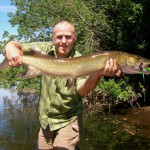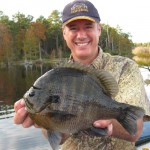By: Adam Glickman – Date Posted: September 15, 2011
Fall is the most productive time of the season to fish muskies in the upper Midwest, both for numbers of fish and large individuals. The calendar year is broken down into four seasons, fall being a single and whole season. However, as a musky fisherman I break fall down further into three separate seasons that span the months of September, October, and November: early fall, fall transition, and late fall. These four seasons have distinct and separate conditions that affect my decisions concerning which type of waters I will fish, how I will pattern muskies in those waters, and what presentations I will use.The Progression of Fall
Early fall in the upper mid-west starts at the beginning of September or late August depending on weather and latitude. At this time, the water is just starting to cool off as the heat of summer subsides. The days may still get very hot, but the cool nights have allowed water temperatures to drop back a few degrees from stressfully warm conditions at or above 80 F. Muskies that had been largely inactive invade forage rich structure and make up for lost time and opportunities for caloric consumption. I have found that the magic temperature for this surge in feeding is 76 F. If summer water temperatures never reached higher than 80 F, then said bite will likely never occur. Conversely, the longer the duration of stressful summer water temperatures, the better the cool down bite will be. Latitude, type of water body, and summer weather will be the key determining factors of water temperature during this period.
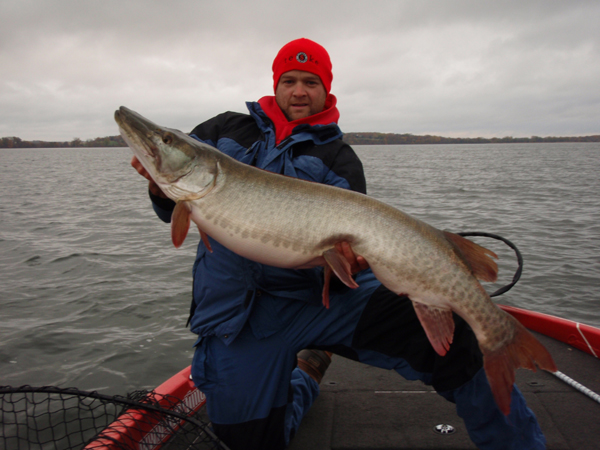
The fall transition begins when lakes that stratify undergo fall turnover and bodies of water that do not stratify cool to the low 50’s F, and turn to cool water environments. Turnover occurs when the upper layer of stratified lakes cools to the temperature of the middle layer (thermocline) and mix. Next, when the temperature of those combined layers reach the temperature of the lower layer, they mix as well. Turnover usually occurs as surface temperatures reach 50 F sometime in late September through late October, depending on latitude and weather conditions. Visually, turnover can give the lake a cloudy appearance, as the mixing of the layers often stirs up debris. Turnover is marked by poor fishing, caused by instability. Turnover usually lasts 1-3 weeks, and completes when the lake is uniform from top to bottom in both temperature and dissolved oxygen. Rivers, streams, very shallow lakes, some wind-swept lakes, and reservoirs with high water flow do not stratify and therefore do not undergo turnover. Lakes that do stratify undergo turnover at different times.
The late fall period runs from after the fall transition period until total ice up on lakes and until rivers drop to and below 36 F. The late fall bite begins in mid to late October and runs to the end of November give or take a week. The most consistent action is experienced at water 40-50 F, and the best big fish potential is seen from 39-46 F. These temperatures are well below what is considered the peak activity level for muskies, but nonetheless they feed more during the late fall period than at any other time of the year.
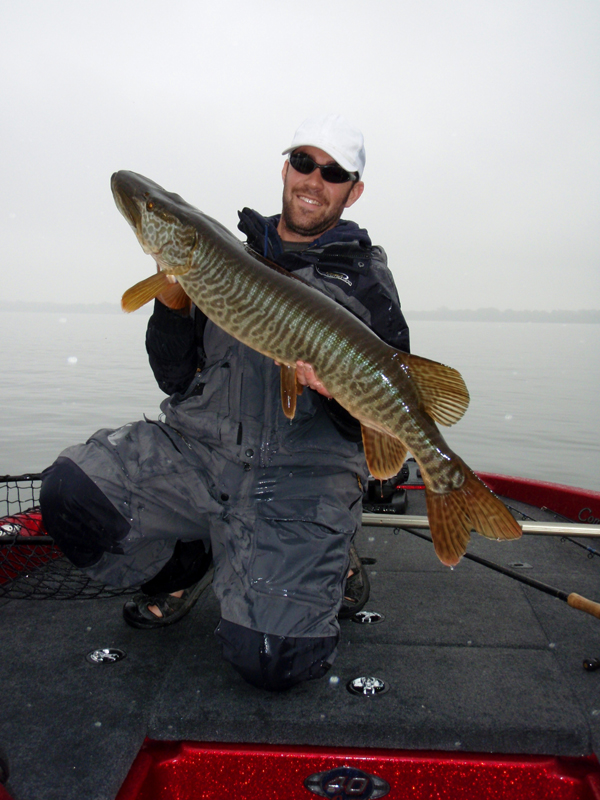
Presentations
The three fall periods cover water temperatures from 76-37 F. Therefore, almost all types of presentations and tactics will have their time and place, but matching the presentation and tactic to the specific set of given conditions will allow the greatest success rate. At warmer water temperatures during early fall, summertime tactics will still produce and often are the most effective. However, as the water cools, more standard fall fare becomes the norm. Traditional jerkbaits, crankbaits, and live bait will shine; but modern soft plastic lures also make excellent cool water presentations.
Jerkbaits are my favorite lures to use in any season, but especially during fall. Jerkbaits have been considered go to fall artificial lures for decades, and for good reason. They have erratic action, that when combined with a pause, proves deadly on muskies that are willing to strike, but need that extra trigger to tease them into it. Jerkbaits fall into two main categories, gliders and divers. I use both, and with proper weighting my jerkbaits will run .5-40’ deep, so I can fish anywhere in the water column there may be hungry fall muskies. I use Manta Hang 10’s for all of my shallow structural needs. The Manta has a wide consistent glide. It runs .5-2’ below the surface, and works very well around shallow structure. The Mr. Automatic is a great glider for working deeper structure. It runs 4-10’ deep with longer pauses, and glides well. It is not quite as smooth on the glide as the Manta, but it is still very good. For deeper applications I like the Bobbie Bait, which is a classic dive/rise style jerkbait. I weight them with lead for four different styles: slow rise, perfect neutral, slow sink, and fast sink. At various weights, they will run 8-40’ deep.
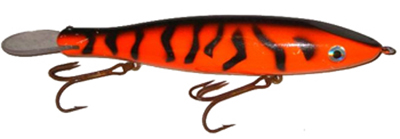
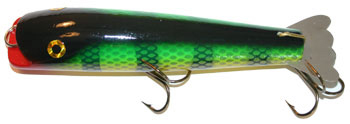

Crankbaits are excellent for deep water applications, both casting and trolling. Floating crankbaits work well for working the 8-18’ zone. Sinking crankbaits are a little less common than floating models, but they are excellent for cold water applications when fishing deep and slow becomes a must. Sinking crankbaits work the 15-35’ zone with ease. When it comes to sinking crankbaits in cold water, straight models usually produce more action than jointed models. Depth Raider Countdowns from Joe Bucher Outdoors and Shark 2-Speed Countdown Crankbaits from River Run Tackle are both good running sturdy lures. Trolling applications for fall muskies are limitless, and when used at the right place and time are very effective.
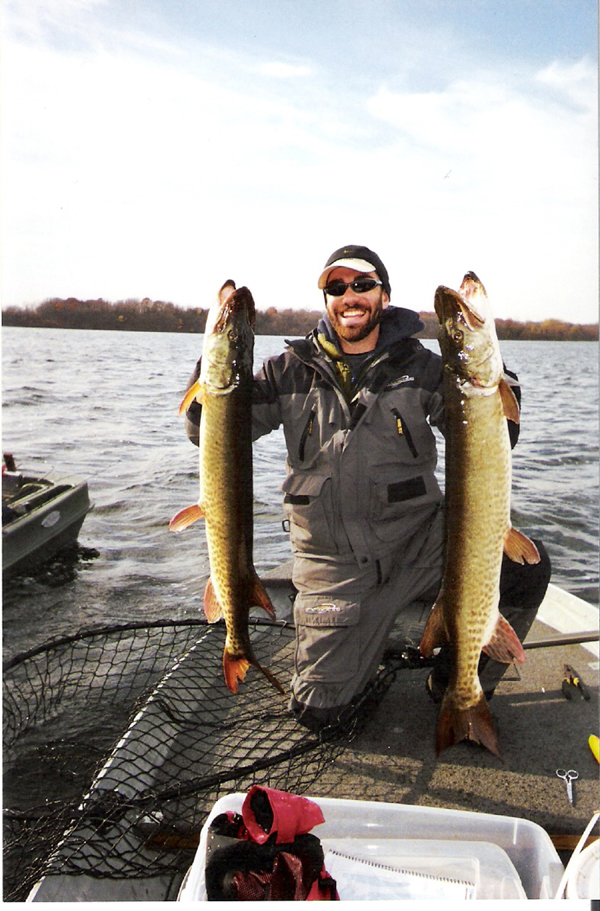
Live bait presentations are another staple of fall musky fishing that are as old as the sport itself. However, techniques for using live bait for muskies have evolved over the years into modern precision tactics designed to work specific depth zones and structure, ensure longevity and action of live bait, and to capture muskies efficiently and without injury. I use live suckers 15-18” long. Any shorter and they don’t get as much attention. Any longer and it becomes harder to get kooks into the muskies. Suckers delicately rigged with 2 or 3 strategically placed hooks allow for high hooking percentages on hook sets performed shortly after the musky takes the sucker.
Rigging the sucker for proper action when slowly trolled is done either by a rubber band run through the sucker’s nostrils, a wire clip run through the nostrils, or a single hook placed very lightly through the front lower lip. Treble hooks on the rig are placed lightly just under ¼-1/2” of skin after the scales on that spot have been scraped free. I use a 7/0 single hook through the lip, a 2/0 treble hook on the back in front of the dorsal fin, and another 2/0 treble hook on the back in front of the tail. I put my hooks through the back instead of the sides to make them more snag resistant so I can work them closer to structure. Off the rear treble hook, I run a light wire arm, a small ball bearing swivel, a short length of elastic band, and a flasher blade to kick behind the sucker as it swims for extra trigger. The sucker should break free from the rig very easily to ensure proper hook ups. It should be so lightly hooked that it needs to be placed in the water by hand and picked up out of the water by hand as well. Lifting it by the rig, line, or rod should cause the sucker to break free and fall off.
For depth control and proper slow trolling (.1-.3 mph), I always work each sucker under a 5 oz. salmon stalker slip bobber with a 4 oz. egg sinker. The elongated bobber keeps it from dragging in the water and sliding down the line when trolled slowly. The large weight keeps the sucker in the depth zone I want and right near the musky holding structure I am working. The weight keeps suckers struggling in one place, which is very tantalizing, but also keeps them from tangling in structure in most cases. Many muskies in fall are very hungry, but somewhat neutral. I have watched rigged suckers with lighter weight escape muskies that I think would have bit. The musky just didn’t want to work that hard. Precision is the name of the game
In the last decade, large musky specific soft plastic lures have been developed and marketed with tremendous success, and for good reason. They catch lots of muskies and big fish as well. These lures come in many sizes, shapes, styles, and weights. They are most effective for working all but the shallowest structure, as even the lighter models sink a little too fast. One problem with many of these lures (even the more popular ones) is that they are not all that durable and often poorly made as their manufacture is frequently outsourced to China. However, Red October Baits out of Buffalo, New York has come up with a great solution to this problem. They make large tubes and twisted tubes that have excellent action, great colors, and interchangeable hardware. When the plastic is shot, the hardware can be removed and put into a new plastic at minimal cost, just like similar lures for any other species. No more $30 lures ruined when the tail falls off after the first hour of casting.
Natural Lakes
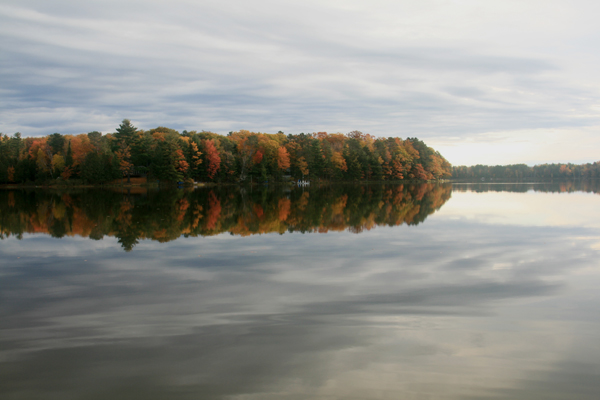
In early fall, natural lakes that come on the best are those that reached water temperatures of 80 F or greater during the summer. For instance the lakes in my neighborhood west of Minneapolis, Minnesota almost always fall into this category, which makes them very tough from the middle of July through mid August. However, as the nights start to cool in late August and early September the muskies invade the shallows to feed as they reach more tolerable temperatures. Fishing is often tremendous at this time, and picking apart key areas of shallow structure pays big dividends. Shallow gliding jerkbaits and topwater lures are amazing at this time. They have excellent triggering ability and hang up little in the shallow cover. Live bait will work at this time, but will not reach its peak strike producing potential until later in the season. Also, higher water temperatures make it tricky to keep baits alive long enough to get eaten. Another factor that draws the muskies in is that these lakes have huge panfish populations that also come into the shallow milfoil as the water cools. Muskies love targeting these vast schools when large populations are present.
Most inland natural lakes stratify during summer, and thus experience turnover during the fall transition period. Fishing is generally poor during turnover, but because of climate differences and physical characteristics of individual lakes, each lake experiences turnover at different times. For instance, the further north a lake is, the cooler the weather will be, and the sooner it will cool and experience turnover. If a lake is smaller, it has less volume at its given temperature than a larger lake in the same climate zone, and will cool faster because the outside temperature affects it at a greater rate. Just as a smaller lake warms more quickly in the spring, they cool more quickly in the fall. Smaller lakes usually experience turnover before larger lakes in the same climate zone. Learning to judge when individual lakes will undergo turnover allows me to avoid them when they do, as action is usually poor. If I want to fish a natural lake during the first part of fall transition, I find those that are pre-turnover. During the last part of fall transition, I look for those that already have. If I must fish a lake that is experiencing turnover (for a tournament or otherwise), I can often find active muskies in very shallow areas that are seeking refuge from the turbulent instability of the process. Topwaters and any other very shallow running presentations work well for such fish.
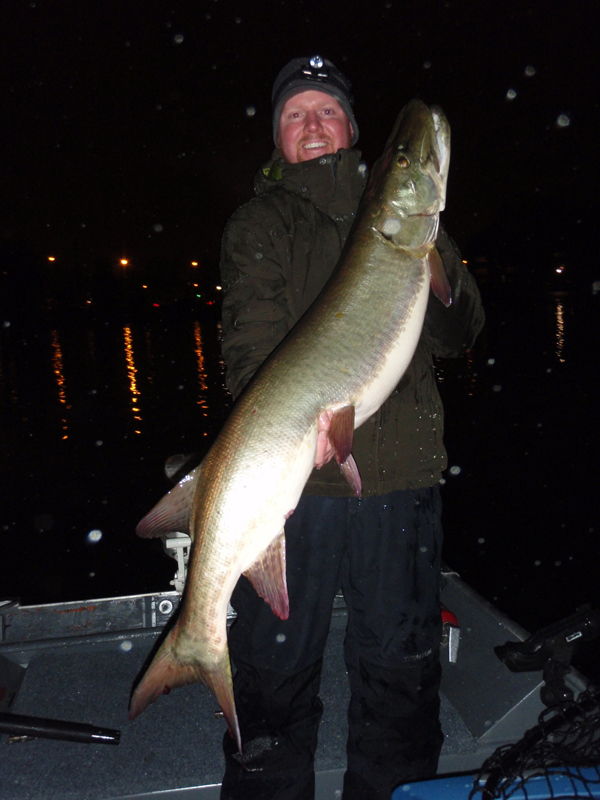
I consider the late fall and post-turnover period on natural lakes to be one and the same. The late fall period is usually the most productive time to fish natural lakes. Good early fall action can rival good late fall action in many ways, but late fall usually reigns supreme on all natural lakes for big musky action. The big girls experience a physiological need to feed and the boating traffic and fishing pressure that puts them down is the lowest it will be all season. Water temperatures experienced during late fall are usually 50-36 F. Presentations that maintain tantalizing action at a slow rate of forward progress are the most effective. For instance I work a Manta Hang 10 with very fast long glides that run almost perpendicular to the path of the retrieve, and I pause it 2-6 seconds in between glides. The speed of the lure when it moves is very fast, but it moves forward very slow. It teases the muskies to the extreme, but gives them lots of time to approach and strike.
The late fall period is the time when I pay very close attention to the type of lake I am fishing and the type of muskies I am fishing for. If I am targeting muskies in northern Wisconsin on deep clear lakes, I am hitting water 15-40’ deep because those muskies tend to work deep structure and forage in late fall. However, if I am fishing for Leech Lake strain muskies in southern Minnesota, I am fishing 2-16’ deep because that type of musky usually uses shallow structure all the way through freeze up, working whatever forage is present. It is just their nature to do so. I have watched them herding, ambushing, and slashing through schools of crappies on a 3’ weed edge at 40 F. Ten years ago, I would never have thought I would witness such a thing, but that just proves the value of experience.
In late fall, the type of forage muskies are using in natural lakes will dictate their location and habits. It is tough to classify an entire natural lake by its forage base, because most natural lakes have at least two different and substantial types of forage. For instance, I will not classify lakes as “sucker” or “cisco” lakes. Lakes with lots of ciscoes usually have a large population of white suckers, and inevitably certain segments of the musky population will chase either or both. Lakes with no ciscoes will often have lots of suckers, but these lakes will also have strong populations of carp and gamefish, such as panfish and walleyes that muskies target at times. Successful anglers take into account every type of forage a lake has to offer its muskies. Overlooking a forage source that many muskies are targeting can make for poor times on the water.
Muskies that target ciscoes are tough customers most of the year. Ciscoes are pelagic and therefore roam in schools over vast open water lake basins in search of plankton and small invertebrates. Muskies base their movements in relation to these schools and predicting and/or locating any of this activity can be very tricky. However, in late fall just before freeze up, ciscoes roam close to their spawning areas and become easier for anglers to locate. Ciscoes spawn near 40 F on main lake shorelines and off shore structure with a sand and gravel bottom that is clean and free of debris. These areas must be directly adjacent to deeper water to give the ciscoes easy access to both their spawning structure and deep water refuge. Usually, they spawn towards the top of a steep breakline. Spawning often takes place around a full moon.
Cisco schools stay very close to these areas for 1-2 weeks in late November and muskies often work them very heavily. Muskies that feed on them all season are already in the area, and other muskies that did not often move in as well to take advantage of the short term vulnerability. At close proximity to shore, the ciscoes eliminate at least one direction of their own escape. Normally, they can flee 360 degrees from muskies when their schools are rushed, but now the muskies can herd them against the very structure they will use to spawn, pinning them in and making them much easier prey. Working presentations right along this structure in anticipation of these movements can lead to excellent days on the water and huge musky encounters. Often the biggest muskies in the lake are those that target ciscoes.

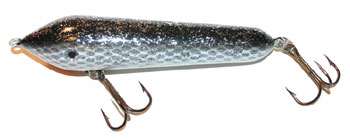
I like to use weighted Bobbie Baits, Mr. Automatic gliders, sinking crankbaits, large soft plastics, and live suckers in these areas. Both trolling and casting presentations can be effective, but I think casting lures and position fishing live bait allows for the closest proximity of presentations to structure which is the key to triggering strikes. Putting presentations directly in the kill zone when the frenzy is on will lead to the greatest success. These frenzies are extremely brief in duration and very sporadic in occurrence, so relentless persistence is crucial on the part of the angler to be in the right place at the right time. I find these schools of forage using my electronics, decide which adjacent structure they are using, and work those areas for long periods of time. If the forage is there, chances are the muskies will be there too, but it can take a little time for them to make their move.
Lakes in the upper Midwest that have no ciscoes usually have sucker, carp, panfish, and/or walleye forage bases. In northern Wisconsin, these species tend to roam deep structure in small schools. Deep in this case is completely relative. In a shallow lake, deep might mean 6-10’, in a deep lake it might mean 20-40’. Fishing deep running presentations precisely around deep structure will produce the best. The name of the game in cold water is always precision. Good looking presentations in the right zone will get bit. I like slow trolling suckers with my electric motor while casting weighted bobbies, sinking cranks, or large soft plastics. I run one sucker 3-5’ above the top of the structure 15-20 yards behind the boat for a boat shy monster, one sucker 1-2’ above the structure 5-10’ behind the boat, and one sucker right beneath the casting anglers half way off the bottom for active followers. Of course, this can only be done where motor trolling is legal. If motor trolling is prohibited, this can be done by rowing. Boat control and closely tended sucker lines are critical, so team work is a must. One person needs to be running the electric motor or oars at all times. With use of the electric motor, the boat control person can make some casts depending on the difficulty of boat control. If rowing, the oarsman won’t be able to cast. At least one more person is necessary to be the sucker wrangler, which can also turn into a hectic job with active suckers and tangling snaggy structure. A third angler to always have an artificial in the water is always nice to keep follows coming in. If I am fishing alone, I fish lakes where trolling is legal, and if conditions are right (usually meaning not too much wind), I can work two suckers and cast an artificial.
In southern Minnesota where I live, the lakes I fish have mostly carp, walleye, bullhead and panfish as the muskies’ forage base. However, as mentioned before, these Leech Lake strain muskies mostly relate to the weed edge which is almost always dense well defined milfoil. They are there all fall, eating whatever is present. Depending on clarity, the edge may be in 3-18’ of water, so whatever presentations work the edge well usually do well. Often, muskies are very high on the edge, but as the water gets very cold they may drop to the bottom of the edge a bit. Water temperature dictates my presentation speed, and if the water is warmer a wide array of baits will work. However, as the water cools, slow baits with lots of trigger and live suckers work the best. When targeting shallow water, topwaters and shallow gliders are my favorite. In deep water, I go to soft plastics and weighted bobbies. Once the water drops below 55 F, I start using suckers. Since it is a shallow weed edge bite, I fish them 15-25 yards behind the boat where muskies feel more comfortable striking them. I work them 2-3’ shallower than the depth of the base of the weedline, so from 1-15’ from the bottom of the bobber to the snout of the sucker. Watching muskies tear after suckers in shallow water is a real treat.
Flowages
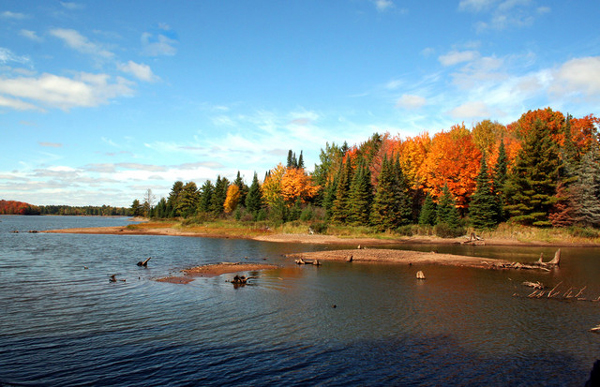
Most reservoirs in the upper mid-west that contain muskies are in Wisconsin. These are mostly low land reservoirs and are referred to as “flowages.” These flowages range in size from under 50 acres to over 20,000 acres. They fish much like natural lakes, especially the larger ones. Most flowages have a forage base of suckers, carp, panfish, and/or walleye; but a few have ciscoes as well. Flowages typically have stained water that looks like tea, root beer, or coffee in appearance. Stained water still has good visibility as long as it is not murky, but the dark nature of the water keeps most of the musky action in the 4-20’ zone. In large flowages, main lake structure such as islands, reefs, points, narrows, and current hold muskies; especially if they are near old river and creek channels. In these areas; rocks, wood, and live vegetation concentrate the most muskies. I target these muskies the same way I would in natural lakes.
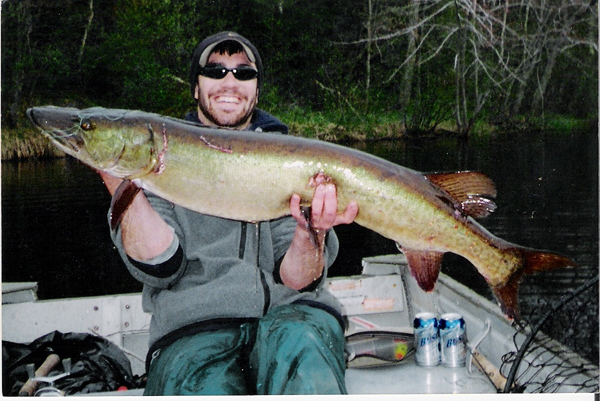
Small flowages fish differently. Most are narrow and fish much like slow stretches of rivers. Look for log jams, fallen trees, rock piles, steep banks, channel edges, currented areas, and any remaining vegetation to be holding muskies. Small flowages that are part of larger river systems are my favorites to fish in fall, because as water temperatures drop, muskies that spent the summer up in the river often move into the flowage in anticipation of winter. This influx of muskies increases the population density and thus forage competition as well. The larger the influx, the larger the increase in aggression, and the better the action will be. Multiple fish days are very possible. I like to drag suckers while working artificial lures. Wind usually isn’t too much of a problem on small flowages so multiple lines and precise boat control become much less of a hassle. I have had 5 suckers eaten in less than an hour on multiple occasions on small flowages. Another benefit of small flowages is that they do not stratify and therefore have a stable bite while other lakes in the area are turning over.
Rivers
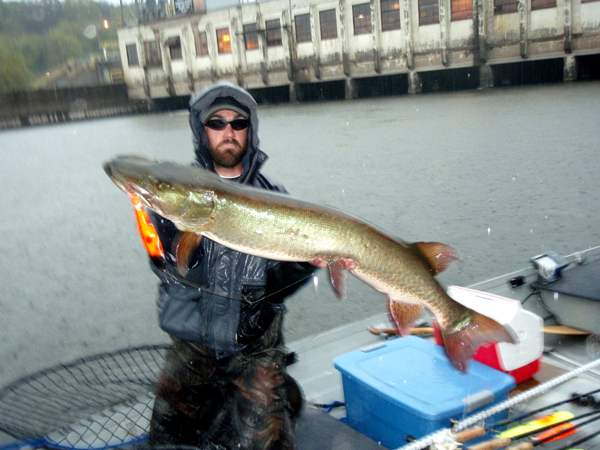
Musky rivers in the upper Midwest are some of my favorite waters to fish. They have prehistoric musky populations that still thrive today and see much less pressure than those in more accessible waters. River muskies are less prone to the negative effects of cold fronts and high skies, but summer often brings instability to rivers in the form of torrential rains. Such instability makes finding good action spotty at best, but during fall the weather and river conditions usually stabilize, and combined with cooling water temperatures, action can be fantastic. Of course, rivers do not stratify and are great options to fish during October while area lakes are turning over. Turnover on lakes can be tricky to judge, so rivers are great for those who don’t want to worry about it.
In small and medium sized rivers, the water continues to cool as fall progresses and muskies and their forage begin to move towards wintering areas. These rivers are mostly swift and shallow (under 6’ deep) and a wintering area is any large deep slower pool, which can be very far and few between. Muskies may have to migrate long distances to reach these areas. They migrate through less than ideal areas using deeper cuts and any structure they can find to lessen their exposure along the way. They can be found and caught from these areas, but covering ground is the name of the game. Places where they rest a bit in their travels are below rapids that will take considerable energy to traverse. They may hole up in a current break waiting to make their move. Of course, a nice meal for an extra boost wouldn’t hurt, and in these areas muskies are vulnerable to a well made presentation.
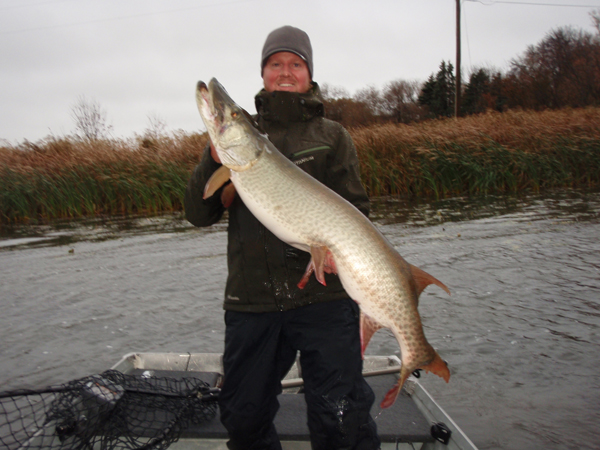
By late October or early November, water temperatures are in the low 50’s F and muskies are pretty much settled into their wintering areas. Most of these areas that I have found are used year after year, and the muskies in them are fairly concentrated, hungry, and aggressive. My favorite lures for targeting these fish are Manta Hang 10’s for working out the upper water column and weighted Bobbie Baits for working a little deeper. I use Bobbies that have a very slow rise and no heavier for the same reason that I don’t use soft plastics much. I want to be able to pause my deep running lures and have them rise out of the heavy structure that is common in rivers. If the water is deeper than 16’ (which is rare), sinking lures will work out the depths nicely and hang up much less than if they are used shallower. Live suckers under bobbers are also very effective in these holes. If the current is slow enough working suckers is fairly easy, if the area has some fast spots a little practice will be needed for proper presentation control. I keep them at half the depth of the water being fished. This will keep them in the strike zone, but will also usually keep them clear of nasty river snags. I run them behind the boat just like anywhere else, but I also like to anchor at the up stream end of the hole and drift them naturally down stream with the current, paying out just enough line to keep up with the current flow, creating a natural drift.
The musky season will usually end before these holes are frozen over. Action will be excellent until water temps reach about 40 F. Colder than that, and action will slow a bit, however the potential for a very large musky is still great. Below 40 F, presentations must be made very slow and deliberate to trigger strikes. Action will get very tough below 36 or 37 F.
Large rivers are much slower and deeper and fish more like lakes than rivers in my opinion. Large rivers in the upper Midwest with musky populations are also much rarer than small and medium sized musky rivers. During early fall, muskies are often holding around the same shallow weedy points that held them during summer. As the water cools, they often abandon these areas to chase forage in the vast depths, where trollers usually have the best action. Muskies follow migratory forage and station around schools of forage preparing to hold for winter. The muskies can be tough to find in these vast environments, but big fish can be caught once they are located and patterned.
Conclusion
I always find it humorous when somebody makes the statement, “It’s a good fall lake.” I can’t think of a musky water that isn’t good in the fall. Fall in the upper mid-west is by far the most productive time to fish muskies. Also, the two greatest annoyances to the musky angler (insects and recreational traffic), have both died off. Timing is everything in fall. Finding waters that are on and avoiding those that are off is critical for success. I waste no time finding water that is on. If I find a bite that is poor, I move to different water immediately. At any one time during fall, there are many waters across Minnesota and Wisconsin with musky populations that are going nuts. Days are short in the fall and the season will be over far too soon.
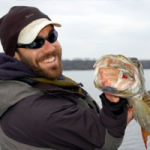 Adam M. Glickman
Adam M. Glickman
Adam Glickman, 33, originally from Ashland Wisconsin but now of the Minnesota Metro area, is field editor with Muskie Magazine, and a frequent contributor to Fishing-Headquarters and the online magazine. In 2014, Glickman began producing his new fishing program: Honest Musky Television is a unique, educational and entertaining fishing show. Our techniques are diverse, versatile, and often cost effective. We always get the strike and hookset on film, and in true honest musky fashion we use no fake hook sets or editing tricks. Glickman and his team films on a vast variety of aquatic environments from the smallest streams to the largest lakes, and done exclusively on public water, mostly in the Upper Midwest at affordable and realistic destinations.



